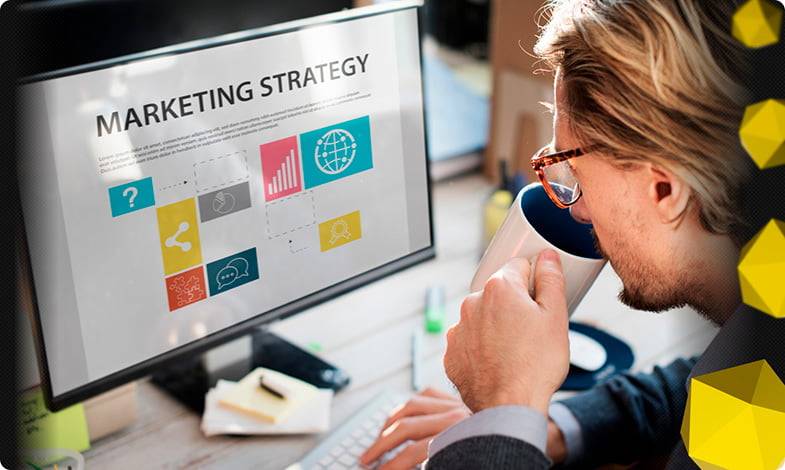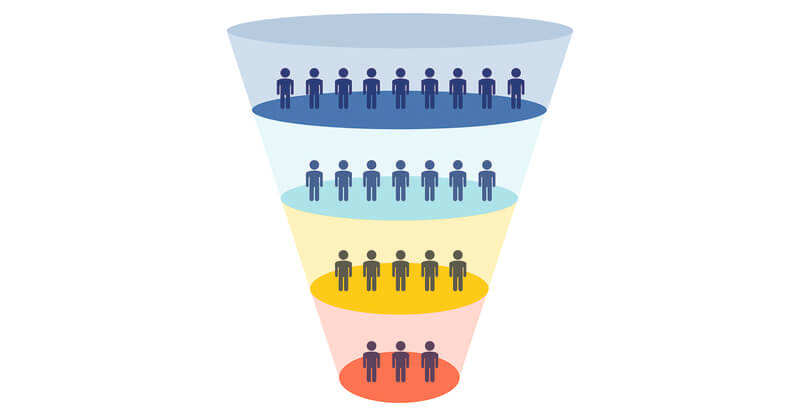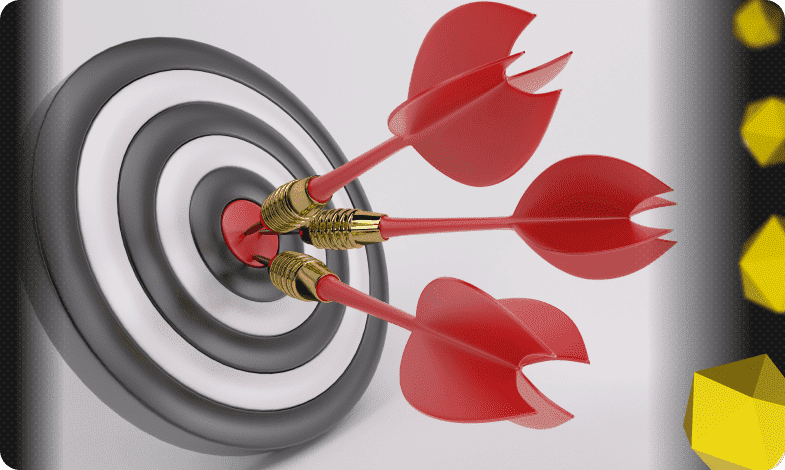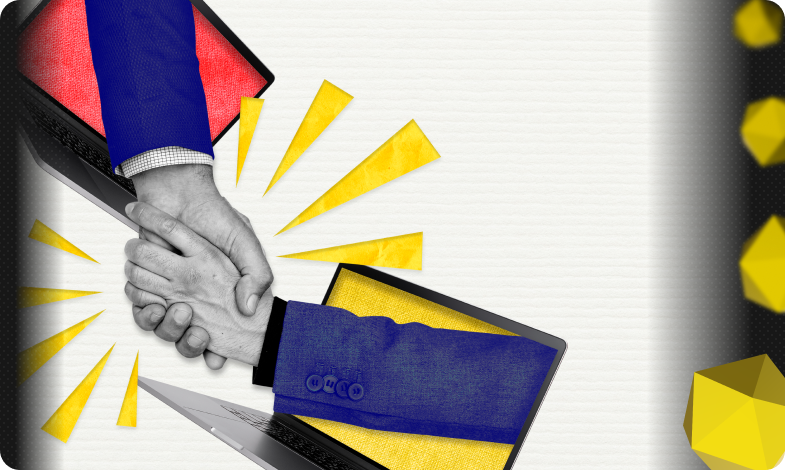Content of the article

Nowadays every brand is trying to get our attention in any way. Marketing is everywhere: from the food we eat to the digital services that help us work and also occupy our free time. Marketing messages have become so familiar to us that we simply stopped noticing them. But when executed well, a good marketing campaign can influence us on an almost subconscious level. Below we will look at what an advertising funnel is, how it works and how to build it correctly.
A marketing funnel is a visualization of the steps that each potential buyer takes from the first contact with the brand to conversions. It is often called a sales funnel. All current marketing funnels are based on the old proven method proposed by American advertising specialist Elias St. Elmo Lewis in 1898. This method is known as the AIDA model.
Why do you need a sales funnel?
It can be used not only to control registration on a site or making a purchase, but also to track how users move around the site.
For example, when registering (viewing the registration page – confirming the registration itself) or subscribing to the newsletter (viewing the subscription form – filling out this form – confirming with an email address).
Stages of the sales funnel

- Awareness – familiarization of a potential buyer with a brand. It is at this moment that the first contact with your company occurs. How is this done online? A person may have seen an advertisement or post related to your business on a social network.
- Interest – interest in your offer appears and grows. Accordingly, the user feels the need to learn more about you.
- Desire – the user hesitates before making a final choice. Now he is trying to make sure that his decision is correct, looking for reviews of what you offer on the Internet and comparing your company with others.
- Action (Action or Purchase) – a purchase is made and the person officially receives the status of your client.
Marketing Funnel Examples Funnel for an online store:
- the user visits the site;
- reviews the product page;
- adds an item to the cart;
- the ordering stage begins;
- The buyer clicks the “Buy” button and thus completes the ordering process.
Retail funnel:
- a potential buyer enters the store;
- examines goods;
- picks up the goods;
- moves towards the cash register;
- pays for the purchase.
The traditional retail funnel has been expanded over time with other stages that also take into account post-purchase activities. This model will give you the opportunity to build long-term relationships with clients and make money from it, forcing them to return to you.
How the stages of the marketing funnel work
Although the funnels differ from each other, they can all be divided into 4 main stages. We will look at each of them in more detail below.
- ToFu (Top Of The Funnel) – the top of the funnel. This is the awareness stage, where the user becomes aware of the existence of a brand or product. At this stage, people usually have a lot of questions. And this is a very good opportunity to get to know your potential customers, their problems and expectations.
- MoFu (Middle of the Funnel) – the middle of the sales funnel. This is the consideration stage where users move from being aware of a product to considering which brands or products might attract their attention. This stage is divided into several more:
- Desire – when a person develops and increases the desire to purchase a certain product.
- Intent is when a customer has the intention to buy a product.
- Evaluation is when the buyer compares products to find the one that best suits his needs.
- BoFu (Bottom of the Funnel) – bottom of the funnel. This is the decision-making stage. Here the client makes the final decision regarding the purchase of goods. This stage consists of the following steps:
- Decision making – the buyer decides to purchase a specific product.
- Conversion is when a person takes actions that lead to the purchase of the selected product.
- Purchase – this is where money is exchanged for goods. This is the ultimate goal of most marketing funnels.
- Post-purchase stage. This stage is not included in every sales funnel. It is aimed at the customer’s behavior after he has made a purchase and is also divided into 2 steps:
- Loyalty – as the user’s loyalty grows, he will return to the brand to satisfy his needs.
- Advocacy – Customers can leave reviews or make recommendations to new potential customers.
In classic sales funnels, each stage is brand-focused to some extent, i.e. guides customers to make decisions that will ultimately benefit the business by creating profit.
Types of sales funnels
Marketing funnels are as versatile as customers. Some people make a purchase instantly, others take time to make a decision. There are users who need to be “pressured” so that they can begin to trust the brand. This includes: calls, blog articles, emails, webinars. This can be seen in the variety of funnels we will look at below.
- Lead generation funnel. The goal is to attract as many organic (via social media, websites, or word of mouth) and paid leads as possible to grow your email list or build a target audience for a new product.
- Webinar funnel. The goal is to convince users to sign up for the webinar, since webinars are a common way to communicate with the audience and convey exactly how a business can be useful for them.
- Personalized funnel. The goal is to gain insight into the client. Based on the greeting and the following questions, you can determine the user’s needs and direct them to the right page or resource.
- Sales funnel, limited time offer. The goal is to increase sales in a short period. Such offers create a sense of urgency, which leads to increased sales. An offer will sell more if it seems more personal.
- Advertising funnel. The goal is to attract as many potential clients as possible. This funnel puts funnel strategies and targeting into practice to guide the customer to make a purchase.
- Content funnel. The goal is to generate inbound traffic, leads, and sales through organic content. The formation of this funnel begins before content creation by researching the topic and defining it with a concept.
- Call booking funnel. The goal is to maintain sales levels. This funnel will save time by automating orders.
- Feedback funnel. The goal is to receive positive feedback, which will be based on feedback surveys. Moreover, after conducting a customer survey, you can find consumers who are satisfied with the product or service. These are the people who are invited to leave their feedback.
- Outflow funnel. The goal is to reduce the failure rate. A properly configured funnel finds a problem and solves it by offering the client another option. You may need a discount or additional help here. But when combined with a feedback funnel, you can figure out what exactly is causing customer dissatisfaction and eliminate the problem at the organizational level.
How to Create a Marketing Funnel
Building a sales funnel involves some preparatory processes and basic steps. Below we will look at both.

To start creating a funnel, you need:
- Study the audience. The top of the funnel involves targeting a wide range of potential customers, but for good results at the bottom of the funnel, audience research is a must. When you understand who your audience is, their interests, expectations, pain points and behavior on social networks, you can offer successful solutions to the problems of your target audience.
- Create a buyer persona. To create the right buyer persona, you will need answers to the following questions:
- How can the customer benefit from the product?
- What is the reason for purchasing?
- How can the buyer use the product?
- What will motivate him to make a purchase based on his pain points?
Once you understand who your customer is, you can create personalized content that reflects specific consumer needs.
- Attract potential clients. In order to attract the attention of the audience, you need to inform them about the benefits the product will bring, and at the same time arouse interest in the brand. You can attract potential clients using the following methods:
- Promoting content on social networks. According to research, now more than 48% of the world’s population are users of various social networks.
- Blog posts that will indicate the brand’s professionalism in a certain industry.
- Specific examples from practice and customer reviews.
- Optimize conversions. To make this step easier, the purchasing process itself should be accessible and simple. Once leads are converted into customers, you need to continue to maintain a relationship with them because acquiring a new customer is 5 times more expensive than retaining an existing one.
After the preparatory processes, to build an effective marketing funnel, you need to take the following basic steps:
- Development of a current unique selling proposition (USP). It is necessary that it consist of specific numbers, data or even guarantees that will make it truly unique.
- Attracting online and offline leads using advertising and CRM. At this stage, it makes sense to divide the audience into segments and find the most effective channels.
- Informing about the product and fueling interest in it. Here you can use PR and marketing tools.
- Dealing with failures. At this stage, you can reduce lead leakage using surveys and other methods of collecting user opinions.
- Conversion and targeting. At the stage of closing a deal, customer support plays a big role if the sale is completed with the help of managers, as well as retargeting to leads that were close to conversion.
- This stage involves identifying the reasons for lead leakage at each stage of the marketing funnel, working out the weak points of the product based on the results of the survey, and making changes to the USP.
- Increased conversion. This will happen with the right analytics process and minimizing lead churn.
Sales funnel analysis
Each level of the funnel needs to be analyzed in terms of process optimization and lead outflow for it to work effectively. What is included in the analysis process? Let’s look at it in detail below.
- Monitoring important KPIs. Each stage of the funnel consists of many metrics that work in the background. Some of them play a decisive role in the success of a particular business. These include:
- number of customer and revenue churn;
- number of active users and daily registrations;
- the overall level of conversions along the funnel for a specific reporting period.
- Using heat maps to understand user behavior. Funnel visualization tools with built-in heat maps are a good way to understand audience behavior (especially in real time). Heat maps are graphical representations of data where an individual matrix shows the stored values as colors. Heat maps can help you see where the most activity is happening on your site. This can then be taken into account when optimizing your pages.
- Funnel visualization. The best way to dive into the analysis (when you already have conversion data for each stage of the funnel) is to visualize it. Major optimization decisions can then be made.
- Adjusting the funnel order. Site visitors may not always navigate the site linearly. Changing the order is a good way to analyze the flexibility of your funnels and consider opportunities that will help increase conversions. By moving the stages of the funnel, you can understand who moved along it and how.
Let’s summarize
In the article, we looked at what a marketing funnel is, its types, how it works and what needs to be done to create it. The sales funnel has been, remains and, most likely, will be an effective marketing tool that changes with the development of technology, but at the same time its main principles have remained unchanged for more than a decade. With its help, you can gradually turn the bulk of your audience into regular customers, which in turn will have a positive impact on your business.






 19/10/2023
19/10/2023  2649
2649



